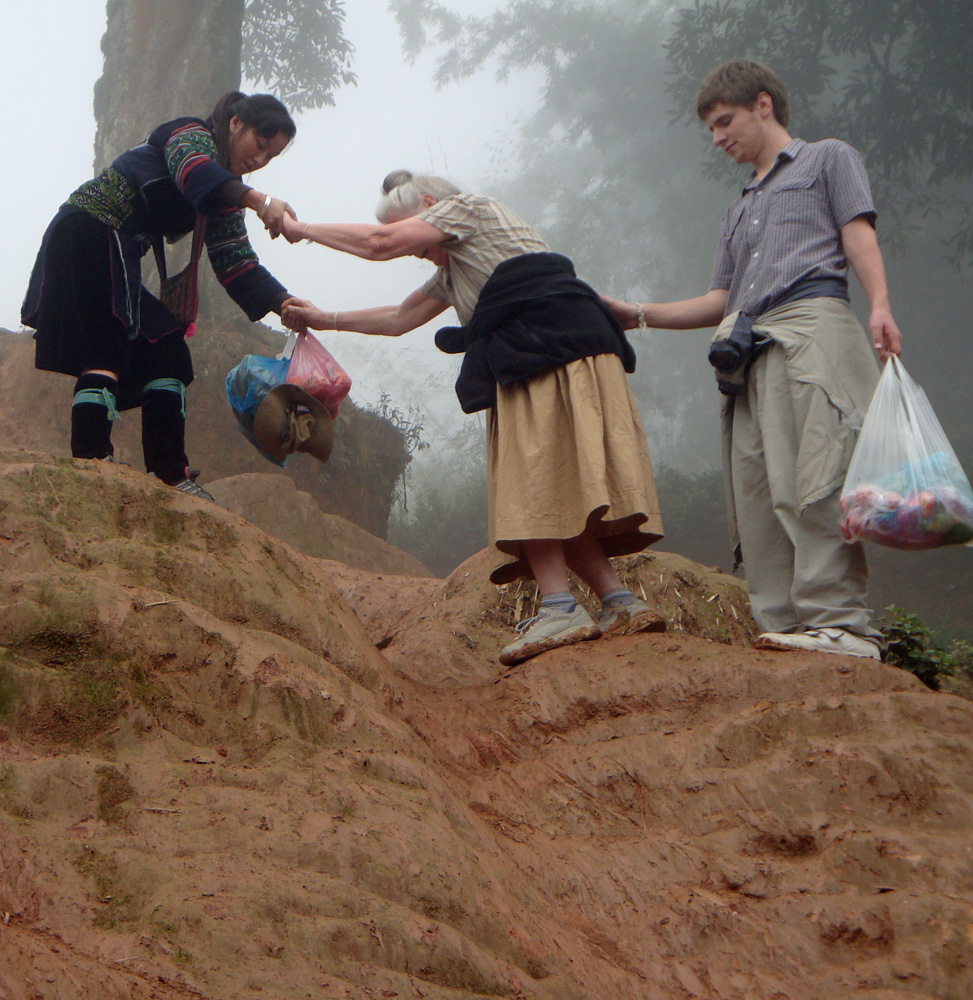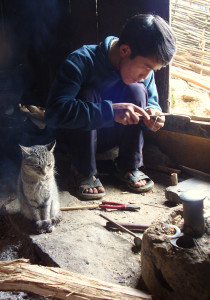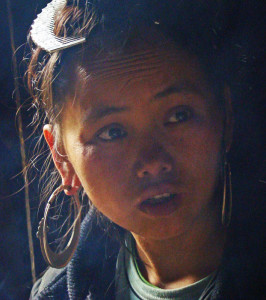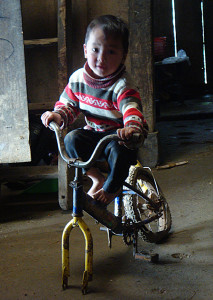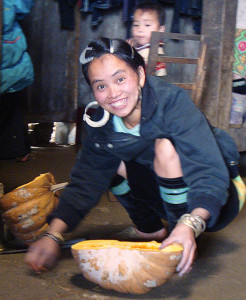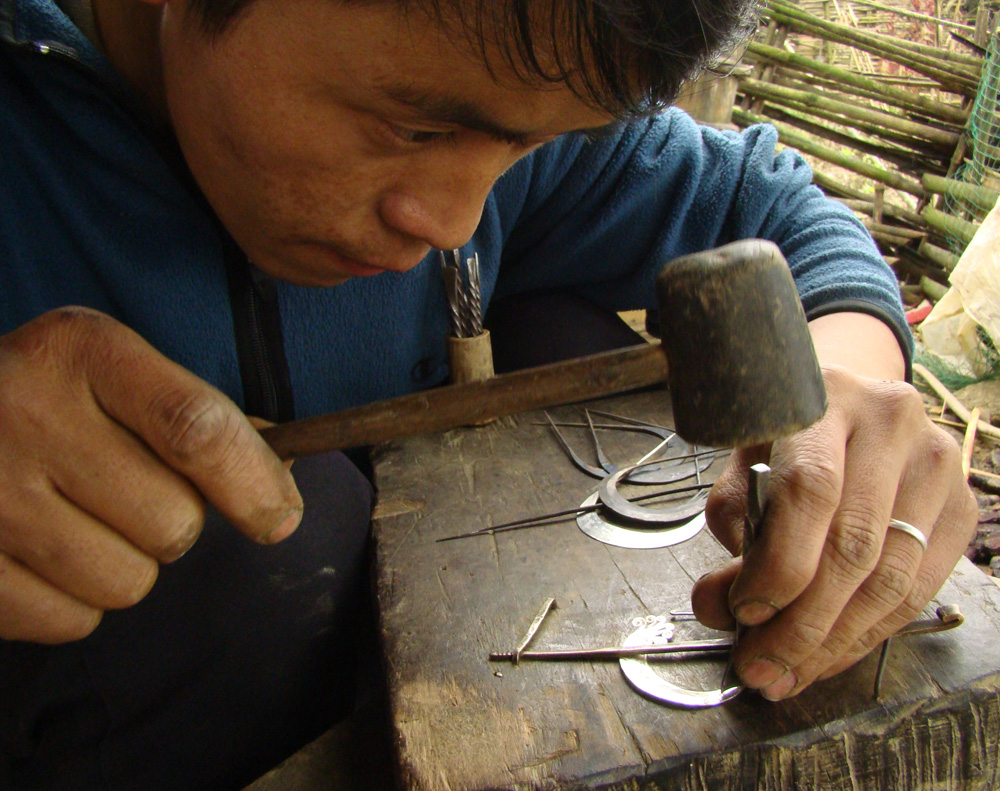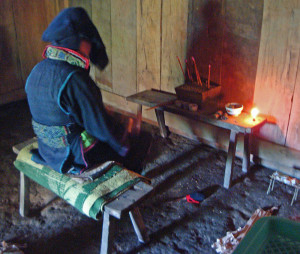Trekking to Trang & Tea’s; Trang’s Traditional H’mong Jewelry
I wasn’t sure we’d make it. Between the recent soaking rains and the prevailing hilltribe conviction that switchbacks are inefficient, the steep route ahead look unforgivingly slick. Especially for my 79-year-old mom.
Our friend and guide, Sho Lythi (featured in Newsletter #6), led the way. “My brother-in-law Trang is just up the hill,” she chimed. “Maybe 20, 25 minutes more.” Of course she weighs about 80 lbs. and has danced on these slippery slopes since she could first walk. “This is no problem – I will help your mother. I will pull her from above, and you can push from below.” My confidence was not increasing.
10 minutes later, Sho’s sister, Tea, came gliding down the thick mud slope. Incredibly, not a spatter of muck touched anything but her thin flip-flops. She laughed as she looked at our trepid stance. Tea said something coyly in H’mong to Sho and quickly fell to pushing and pulling us up to her modest home at the very top of the habitable mountain-side slope. Fortunately, we encountered no crisis that the laundry couldn’t resolve.
Tea’s home nestled on a carved terrace ledge overlooking the valley; each 10-foot wide terrace had an abrupt wall-edge that dropped several feet to meet the next terrace. Scraps of wooden branches were cleverly woven into fences to protect the precarious mud-walls from the pigs, buffalo and humans that might damage the sculpted farmland. Being winter, the terraces lay mostly fallow save for a few pumpkin plants and a rich array of leafy greens. Spring would see corn, rice, and other crops filling every fertile corner.
Tea’s husband, a talented Black H’mong metal-smith, greeted us shyly, then returned to his crouched position next to the slatted window that allowed sunlight to illuminate his workspace. A variety of small hammers, pliers, and metal punches sat on a work stump. He worked quickly, methodically, efficiently; metal shavings littered the ground at his feet. He was eager to complete the “fern-frond” earring set before lunch, knowing he had one more sale if he could finish the task. And, in truth, we bought every necklace and set of earrings he completed.
Tea disappeared into the side-room kitchen as Sho stoked the living area fire with one stick of hardwood and a couple splinters of wide bamboo. We all appreciated the extra warmth on this mid-winter day, and the smoke smelled good. To a westerner, the home, like much of rural Vietnam, offered an eclectic mix of Spartan simplicity and modern practicality. The simple fire on the dirt floor was juxtaposed with the rice cooker’s glowing red light. Tea and Trang’s youngest son, a smiley 3-year-old, played on a wheel-less bicycle set in the front room. A large sow slept a few feet outside of the front door, and grunted greedily when a pumpkin was split open. The daughter helped wash greens using the hand-pump in the kitchen. Drying corn hung from the rafters.
Sho had thoughtfully requested that we purchase food at the morning market to contribute to the meal as the family’s means were modest, and the addition of our appetites would stretch their resources. Within an hour of our arrival, a large meal was set for our family of five plus five more – the adults guests got to use the four chairs. Steaming plates of greens with pork and ginger, fresh bamboo shoots with buffalo, fresh tofu from the morning market with tomatoes, and garden pumpkin soup were served with gracious smiles all around. It was delicious!
Trang had learned his metal-working skills from a local elder. Trang knew that farming alone would not support his family in this sparse environment, and living a couple hours walk away from the tourist town of Sapa granted him access to a wider customer base. Several members of the extended family (which including Sho before she moved on exclusively to guiding services) offer his jewelry to both western and Vietnamese tourists in the local market.
Trang can work with silver as well as nickel-bronze. But the high up-front cost of silver and its limited market appeal pulls Trang to work more with nickel-bronze. Most H’mong women as well as tourists prefer more affordable nickel-bronze or aluminum “bling” as well; locals relegate silver jewelry to wedding-wear and dowry value, and not to the desired everyday use of bright dangly and hoop earrings and extravagant necklaces.
After three hours of eating and chatting, and our promise to sell Trang’s jewelry in the USA and come back seeking more, we gathered up our treasured bag of finished jewelry and prepared to slide back down the mountainside. Luckily, an hour of afternoon sun had set the mud a bit firmer, and our careful steps, with Sho’s firm support and freshly-chopped bamboo walking sticks, got us back down the hill without catastrophe.
Near the bottom, we heard a constant drumbeat and a monotone female chant coming from another hillside home. A rather distraught and inebriated gentleman stumbled out of his dark, smoky home and, bleary-eyed, indicated for us to enter his home. Sho confirmed that indeed a H’mong shaman had been hired to clear his home of recent illness. We were unsure as to whether it would be appropriate for us to interrupt the healing ceremony, although we were intrigued with the rare opportunity to see a shaman in trance doing her work. The man looked desperate and again, through Sho, urged us forward. We tiptoed into the dark home, and watched the candlelit shaman rock back and forth intently as she wailed a fast, tuneless prayer. We stayed only a minute or two, feeling both honored and out-of-place. The old man nodded quickly as we bowed with gratitude for the honor of bearing witness to the ceremony. Afterward, Sho confided to us that the elder thought our family’s presence in his home might intimidate the malevolent spirits so they would exit more quickly.
The gracious kindness of Trang and Tea and the heartfelt plea of a mourning elder were the bookends of an amazing afternoon’s adventure. And we can’t let the story go by without thanking Sho Lythi and her extended family for welcoming us into their lives in rural Lao Cai Province in northern Vietnam; she has opened so many unusual and wonderful doors for both our pleasure and our business.


